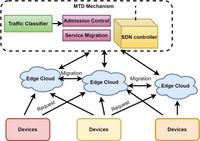A new adaptive defense mechanism using moving target defense (MTD) is proposed to enhance security against DDoS attacks in industrial Internet of Things (IIoT) environments, crucial for maintaining the performance of critical infrastructures.
The key industries essential to society, including healthcare, transportation, manufacturing, and energy distribution, face growing threats from escalating distributed denial of service (DDoS) attacks. These attacks pose significant risks to the stability and functionality of industrial systems leveraged by the IIoT. Tapping into the advantages of Industry 4.0, changes in operational efficiency have evolved in tandem with smart technologies; however, vulnerabilities have surged alongside them. The MTD Traffic Manager (MTDTM) architecture, recently announced in a comprehensive study, aims to fortify IIoT security through sophisticated means.
One of the fundamental weaknesses of IIoT arises from its reliance on edge computing. As edge servers are integral to processing data from IoT devices, their limited computational and storage capabilities make them highly susceptible to resource-exhaustive attacks. DDoS attacks can trigger a domino effect, endangering interconnected systems and jeopardizing critical infrastructures. In response, various DDoS mitigation strategies have been proposed, yet traditional defenses often require prior knowledge of attack patterns, making them less effective against evolving threats. This necessitates a shift toward adaptive and proactive security solutions.
The MTDTM architecture addresses these challenges by implementing advanced techniques in real-time processing and resource allocation, ensuring that institutions can respond effectively to shifts in malicious attack vectors.
Unlike prior methods that offer static defenses, the MTDTM uses intelligent traffic classification and dynamic admission control to rapidly identify and respond to harmful traffic, ensuring that legitimate service demands are not impeded during a DDoS incident. Furthermore, the dual mechanisms highlighted in this model—traffic classification and service migration—allow critical industrial processes to remain unaffected.
For instance, the authors of the article note, "The proposed solution aims to proactively address security vulnerabilities while preserving the performance and reliability of critical IIoT services." This adaptability proves crucial in a landscape where attacker tactics are continuously evolving, requiring systems that can adapt dynamically.
Through simulation results, the MTDTM has demonstrated a 15% to 20% improvement in service response times compared to existing algorithms while enhancing the average resource availability during DDoS attacks. Such results validate the effectiveness of the proposed architecture.
The architecture applies a hybrid traffic classification model using ODENet and LSTM, which greatly improves detection capabilities and minimizes false positive scenarios, enabling early identification of anomalous patterns typical of DDoS attacks. In addition to this traffic classifier, service migration allows the architecture to seamlessly transition operations across edge nodes in the event of an attack, ensuring no single resource is overwhelmed.
To provide an in-depth security overlay, the MTDTM employs a weighted load-balancing mechanism that capitalizes on the dynamic nature of IIoT applications. This means that during heightened traffic conditions, the architecture engages a decentralized gossip protocol, ensuring that nodes can quickly share load information and reduce congestion.
The implications of this system extend beyond merely maintaining operational status—but rather, they also reflect an innovative move towards resilient and responsive infrastructures capable of withstanding sophisticated cyber adversaries.
Ultimately, the significance of this new architecture lies in its capacity to maintain quality service availability amid evolving threats. As the authors conclude in their study, "Our research demonstrated a 15% to 20% improvement in service response times compared to existing algorithms," a clear testament to the potential of MTD to revolutionize the security landscape of IIoT systems.
This adaptive proactive framework represents a pivotal step in safeguarding critical industrial processes and ensuring systems remain functional and secure even in the face of extensive cyber threats.




